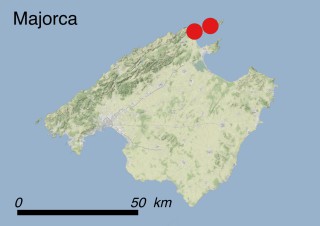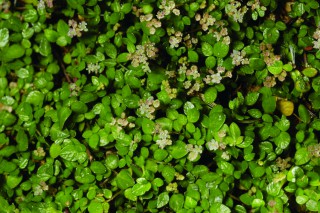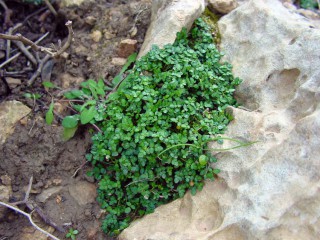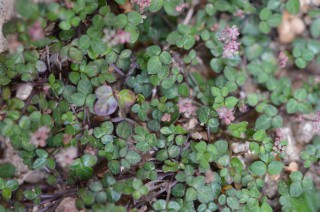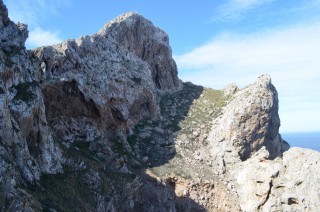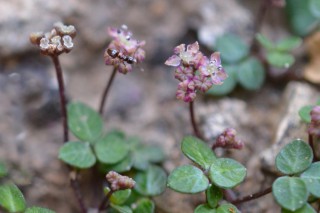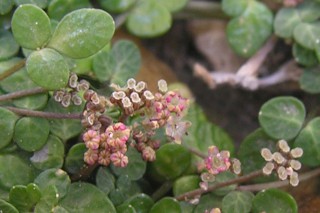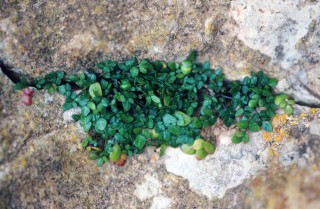Where is it found ?
Naufraga balearica occurs only on the island of Majorca, where it is found at the base of coastal cliffs (habitat 3.8.3: Spiny Mediterranean heaths - phrygana, hedgehog-heats and related coastal cliff vegetation) in the northern part of the island. The population is fragmented and forms several isolated subpopulations along ca. 10 km of coastline. The species usually grows in shady cracks on boulders where some calcareous soil or clay has accumulated, and it needs humid conditions. Another subpopulation was discovered in 1981 on the western coast of Corsica, between Cargèse and Piana, but it had disappeared by 1983, just two years after its discovery. There is some doubt as to whether this was truly a native population.
How to recognize it ?
This perennial herbaceous plant has a very small size for a member of the celery family and is only 2-4 cm tall. It has numerous lateral shoots which emerge from the base of the plant in spring, each with a simple, rather than compound, umbrella-shaped inflorescence at their tip. The leaves form a flat rosette, and each leaf is divided into three to five oval leaflets. The center of the rosette may produce inflorescences too. The greenish white flowers are very small (about 2 mm in diameter) and open between May and July. Fructification occurs in summer. Often many rosettes grow together forming dense and continuous lawns, which makes it very difficult to recognize single individuals.
Interesting facts
This species is the only representative of the genus Naufraga. While the plant can reproduce from seed, it can also form new individuals through lateral shoots. The flowers are pollinated by ants. As the tiny flowers are grouped close together and lay near the ground ants can quickly visit them to seek nectar, and thus transfer pollen from one flower to another. Fruit dispersal strategy is barochory.
Why is it threatened ?
This species has been categorized CR (Critically Endangered) according to IUCN Red List Criteria B1ab(ii+v)+2ab(ii+v). This means that its range is very limited, the population is fragmented, and the number of mature individuals is in decline. It has been observed that this plant has a weak capacity to recolonize sites where it has previously disappeared. Monitoring in permanent plots set up since 1998 shows a steady decline in the observed populations, particularly serious in the case of the "locus classicus". After twelve years of monitoring, the population cover was reduced at less than one half of its original size.
Small, scattered and isolated subpopulations cover an area of less than 1000 m2, which makes this species very prone to extinction. N. balearica is sensitive to droughts, mainly in spring, and to heat waves during summer (threat 11.1: Droughts). Repeated droughts over the last 20 years have resulted in a continuous decline in the number of individuals. Climate change and a scenario of a warmer, drier climatic regime puts this species at risk. Some other co-occurring plant species such as Dactylis glomerata (threat 8.2.2: Problematic native species/diseases - Named species) may represent a serious danger by outcompeting N. balearica because they are more drought-resistant and have a greater growth capacity under optimal climatic conditions.
N. balearica is also threatened with intensive trampling by goats (threat 2.3.2: Small-holder grazing, ranching or farming), although grazing may also help reduce the competition of other species, mainly grasses.
N. balearica is completely dependent on a few ant species for sexual reproduction. The disappearance of these ants (e.g. through the introduction of non-native ants) could represent a severe threat for the survival of the species (threat 7.3: Other ecosystem modifications).
What has been done to protect it ?
Legally: This species is listed in the Annex of the Spanish Royal Decree 139/2011 with the category of ‘In Danger of Extinction’. N. balearica is included in two international documents: Appendix I of the Bern Convention and Annexes II and IV of the EC Habitats Directive as a priority species. Nevertheless, no recovery plan has been approved since then. The population falls within the Natura 2000 site ES5310127 ‘Costa Brava de Mallorca’.
In situ: In 1997 within the framework of an EU LIFE project entitled “Conservation of natural habitats and plant species in Corsica”, several projects were undertaken which included habitat protection, land acquisition, and restoration work for this species. A re-introduction attempt on Corsica using material from the Conservatoire et Jardin Botaniques of Geneva (Switzerland) was unsuccessful. On the Balearic Islands, a conservation programme undertaken by the University of Balearic Islands (UIB) and financed by the MAVA Foundation was launched in 2003, and a monitoring study with permanents plots was carried out between 1998 and 2010. Moreover, in depth studies about the reproductive biology of this species were done by the UIB staff.
Ex situ: Material collected from the Balearic Islands is being cultivated in the Universidad Politécnica of Madrid (BGV-UOM) and in the Botanical Garden of Sóller on Majorca. Corsican material (all of the same provenance) has been cultivated in the botanical gardens of Geneva (Switzerland), Brest and Porquerolles (France) since 1981, when the population on Corsica was discovered.
What conservation actions are needed ?
The assessment of the most adequate conservation actions for this species is complex. The goat population should be reduced but not totally eliminated in order to control co-occurring grass competition. Because of its sensitivity to climate change, in situ conservation in the original locations is threatened in the long run. It is therefore very important to maintain several viable seed banks covering the genetic variability of all populations. It would also be necessary to learn how to do translocations, and write a protocol that can be used if considered necessary. For this purpose, it is also important to improve species distribution modelling in order to obtain a map of potentially suitable localities for future translocations. Finally, maintaining a monitoring system using permanent plots is essential to know the current and future state of populations and their evolution.
Scientific coordination
Dr. Juan Rita, University of the Balearic Islands.
Dra. Joana Cursach, University of the Balearic Islands.
Sr. Pere Fraga i Arguimbau, Institut Menorquí d’Estudis.
Sr. Biel Bibiloni, University of the Balearic Islands.
Dr. Eva Moragues, Government of the Balearic Islands.
Dr. Mauricio Mus, University of the Balearic Islands.
Dr. Llorenç Sàez, Autonomous University of Barcelona.
Photos
Dr. Eva Moragues, Government of the Balearic Islands.
Dr. Juan Rita, University of the Balearic Islands.
Josep Lluis Gradaille, Jardí Botànic de Sóller.

